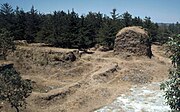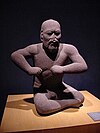Portal:Mesoamerica
Mesoamerica (Spanish: Mesoamérica) is a region and cultural area in the Americas, extending approximately from central Mexico to Belize, Guatemala, El Salvador, Honduras, Nicaragua, and Costa Rica, within which a number of pre-Columbian societies flourished before the Spanish colonization of the Americas in the 15th and 16th centuries.
As a cultural area, Mesoamerica is defined by a mosaic of cultural traits developed and shared by its indigenous cultures. Beginning as early as 7000 BC the domestication of maize, beans, squash and chili, as well as the turkey and dog, caused a transition from paleo-Indian hunter-gatherer tribal grouping to the organization of sedentary agricultural villages. In the subsequent formative period, agriculture and cultural traits such as a complex mythological and religious tradition, a vigesimal numeric system, and a complex calendric system, a tradition of ball playing, and a distinct architectural style, were diffused through the area. Also in this period villages began to become socially stratified and develop into chiefdoms with the development of large ceremonial centers, interconnected by a network of trade routes for the exchange of luxury goods such as obsidian, jade, cacao, cinnabar, Spondylus shells, hematite, and ceramics. While Mesoamerican civilization did know of the wheel and basic metallurgy, neither of these technologies became culturally important.
Among the earliest complex civilizations was the Olmec culture which inhabited the Gulf coast of Mexico. In the Preclassic period, complex urban polities began to develop among the Maya and the Zapotecs. During this period the first true Mesoamerican writing systems were developed in the Epi-Olmec and the Zapotec cultures, and the Mesoamerican writing tradition reached its height in the Classic Maya Hieroglyphic script. Mesoamerica is one of only five regions of the world where writing was independently developed. In Central Mexico, the height of the Classic period saw the ascendancy of the city of Teotihuacan, which formed a military and commercial empire whose political influence stretched south into the Maya area and northward. During the Epi-Classic period the Nahua peoples began moving south into Mesoamerica from the North. During the early post-Classic period Central Mexico was dominated by the Toltec culture, Oaxaca by the Mixtec, and the lowland Maya area had important centers at Chichén Itzá and Mayapán. Towards the end of the post-Classic period the Aztecs of Central Mexico built a tributary empire covering most of central Mesoamerica.
Selected article

Qʼumarkaj, (Kʼicheʼ: [qʼumarˈkah]) is an archaeological site in the southwest of the El Quiché department of Guatemala. Qʼumarkaj is also known as Utatlán, the Nahuatl translation of the city's name. The name comes from Kʼicheʼ Qʼumarkah "Place of old reeds".
Qʼumarkaj was one of the most powerful Maya cities when the Spanish arrived in the region in the early 16th century. It was the capital of the K'iche' Maya in the Late Postclassic Period. Archaeologically and ethnohistorically, Qʼumarkaj is the best known of the Late Postclassic highland Maya capitals. The earliest reference to the site in Spanish occurs in Hernán Cortés' letters from Mexico. Although the site has been investigated, little reconstruction work has taken place. The surviving architecture, which includes a Mesoamerican ballcourt, temples and palaces, has been badly damaged by the looting of stone to build the nearby town of Santa Cruz del Quiché.
The major structures of Qʼumarkaj were laid out around a plaza. They included the temple of Tohil, a jaguar god who was patron of the city, the temple of Awilix, the patron goddess of one of the noble houses, the temple of Jakawitz, a mountain deity who was also a noble patron and the temple of Qʼuqʼumatz, the Feathered Serpent, the patron of the royal house. The main ballcourt was placed between the palaces of two of the principal noble houses. Palaces, or nimja, were spread throughout the city. There was also a platform that was used for gladiatorial sacrifice.
Selected biography

William Hickling Prescott (May 4, 1796 – January 29, 1859) was an American historian and Hispanist, who is widely recognized by historiographers to have been the first American scientific historian. Despite suffering from serious visual impairment, which at times prevented him from reading or writing for himself, Prescott became one of the most eminent historians of 19th century America. He is also noted for his eidetic memory.
A direct descendant of the revolutionary American officer William Prescott, William H. Prescott spent his childhood and adolescence in Boston, Massachusetts. Prescott attended Harvard University, and considered a legal career, but his poor health prevented him from working professionally and he therefore dedicated himself to a life of writing. After an extensive period of study, during which he sporadically contributed to academic journals, Prescott specialized in late Renaissance Spain and the early Spanish Empire. His works on the subject, The History of the Reign of Ferdinand and Isabella the Catholic (1837), The History of the Conquest of Mexico (1843), A History of the Conquest of Peru (1847) and the unfinished History of the Reign of Phillip II (1856–1858) have become classic works in the field, and have had a great impact on the study of both Spain and Mesoamerica. During his lifetime, he was upheld as one of the greatest living American intellectuals, and knew personally many of the leading political figures of the day, in both the United States and Britain. Prescott has become one of the most widely translated American historians, and was an important figure in the development of history as a rigorous academic discipline.
Did you know?
- ... that art historian George Kubler declared The Wrestler (pictured), an ancient Olmec statuette, "among the great works of sculpture of all ages"?
Subcategories
Related portals
Selected image
 |
Olmec figurines were produced by the Preclassic inhabitants of Mesoamerica. Although not all were produced in the Olmec heartland, they bear the hallmarks and motifs of Olmec culture. Most are simple in design, often nude or with a minimum of clothing, and made of local terracotta. More durable and better known by the general public are those carved from jade and other stones.
Featured articles
Good Topics
Good articles
 Gómez de Alvarado
Gómez de Alvarado Aztecs
Aztecs La Blanca, Peten
La Blanca, Peten Calakmul
Calakmul Bartolomé de las Casas
Bartolomé de las Casas Copán
Copán El Chal
El Chal Haʼ Kʼin Xook
Haʼ Kʼin Xook Itzam Kʼan Ahk II
Itzam Kʼan Ahk II Iximche
Iximche Kʼinich Yat Ahk II
Kʼinich Yat Ahk II Kʼinich Yoʼnal Ahk I
Kʼinich Yoʼnal Ahk I Macuahuitl
Macuahuitl Maize
Maize Manche Chʼol
Manche Chʼol Mixco Viejo
Mixco Viejo Motul de San José
Motul de San José Mundo Perdido, Tikal
Mundo Perdido, Tikal North Acropolis, Tikal
North Acropolis, Tikal Potbelly sculpture
Potbelly sculpture William H. Prescott
William H. Prescott Qʼumarkaj
Qʼumarkaj Resplendent quetzal
Resplendent quetzal Seibal
Seibal Serpent labret with articulated tongue
Serpent labret with articulated tongue Spanish conquest of Yucatán
Spanish conquest of Yucatán Spanish conquest of Chiapas
Spanish conquest of Chiapas Spanish conquest of El Salvador
Spanish conquest of El Salvador Spanish conquest of Honduras
Spanish conquest of Honduras Spanish conquest of the Maya
Spanish conquest of the Maya Tikal
Tikal Toniná
Toniná Western Mexico shaft tomb tradition
Western Mexico shaft tomb tradition Benjamin Lee Whorf
Benjamin Lee Whorf Yoʼnal Ahk III
Yoʼnal Ahk III Zaculeu
Zaculeu
Topics
WikiProjects
New articles
Rules | Match log | Results page (for watching) | Last updated: 2024-05-26 21:07 (UTC)
Note: The list display can now be customized by each user. See List display personalization for details.
- Miss Cosmo International 2024 (edit | talk | history | links | watch | logs | tools) by KamyyFallon (talk · contribs · new pages (1)) started on 2024-05-25, score: 38
- 2024 Mexican Senate election (edit | talk | history | links | watch | logs | tools) by Moscow Mule (talk · contribs · new pages (30)) started on 2024-05-25, score: 54
- Salvadoran campaign of 1832 (edit | talk | history | links | watch | logs | tools) by PizzaKing13 (talk · contribs · new pages (3)) started on 2024-05-25, score: 36
- Third Mexican Provincial Council (edit | talk | history | links | watch | logs | tools) by Moriwen (talk · contribs · new pages (140)) started on 2024-05-24, score: 24
- Juan Martínez Téllez de los Ríos (edit | talk | history | links | watch | logs | tools) by Cesarleonardocruz (talk · contribs · new pages (1)) started on 2024-05-14, score: 24
- Ipomoea setosa (edit | talk | history | links | watch | logs | tools) by WelwitschiaTokarev (talk · contribs · new pages (1)) started on 2024-05-21, score: 56
- Quintonil (edit | talk | history | links | watch | logs | tools) by Tbhotch (talk · contribs · new pages (31)) started on 2024-05-18, score: 36
- List of country subdivision flags in North America (edit | talk | history | links | watch | logs | tools) by For the nth time (talk · contribs · new pages (4)) started on 2024-05-18, score: 26
- Ideoblothrus maya (edit | talk | history | links | watch | logs | tools) by WhatIsAPoggers (talk · contribs · new pages (8)) started on 2024-05-18, score: 40
- List of Michelin starred restaurants in Mexico (edit | talk | history | links | watch | logs | tools) by Expandinglight5 (talk · contribs · new pages (2)) started on 2024-05-17, score: 30
- Chiapanec people (edit | talk | history | links | watch | logs | tools) by Loukus999 (talk · contribs · new pages (13)) started on 2024-05-16, score: 148
- UN Trade and Development (edit | talk | history | links | watch | logs | tools) by Teddyg3892 (talk · contribs · new pages (1)) started on 2024-05-15, score: 24
- General Director of National Planning (edit | talk | history | links | watch | logs | tools) by AlexExpensive (talk · contribs · new pages (4)) started on 2024-05-13, score: 24
Associated Wikimedia
The following Wikimedia Foundation sister projects provide more on this subject:
-
Commons
Free media repository -
Wikibooks
Free textbooks and manuals -
Wikidata
Free knowledge base -
Wikinews
Free-content news -
Wikiquote
Collection of quotations -
Wikisource
Free-content library -
Wikiversity
Free learning tools -
Wiktionary
Dictionary and thesaurus

























